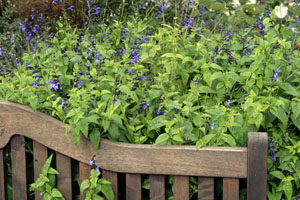
There are about 900 species of annuals, perennials and soft-wooded evergreen shrubs in the genus Salvia (the largest genus in the mint family, Family Lamiaceae), including many species used for culinary and medicinal herbs and as ornamental plants. Blue anise sage, Salvia guaranitica – also sometimes called anise-scented sage, Brazilian sage, giant blue sage, sapphire sage, or various other common names – is native to southern South America (Brazil, Paraguay, Uruguay, and north eastern Argentina) where it’s leaves purportedly were used by the Guarani Indians of Brazil as a sedative. This attractive subshrub (freezing to the ground in winter and sprouting back in spring) is hardy in zones 8-10 but can be grown as an annual in colder climates.
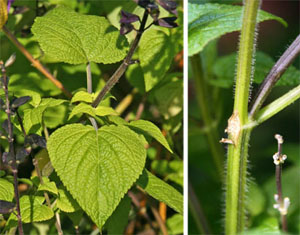
The plants can grow up to 6 feet tall where it is a perennial but remains much shorter when used as an annual. The pointed oval leaves are 2-5” long and lightly sweet-scented but despite the common name, do not smell like anise. They are slightly toothed, hairy and are borne in opposite pairs on the branched, square dark green stems. The leaves are dark green, wrinkled above and pale green below. The plants have a loose, bushy, rather open form. Plants sucker lightly and may form tubers.
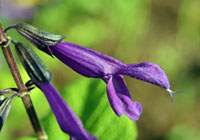
The striking flowers are 1½-2” long, with purple to true blue petals surrounded by a green calyx. The petals form a hood-like upper lip and a shorter, downward pointing lower lip, sort of resembling an open parrot’s beak or snake’s mouth, around whisker-like stamens. The flowers are produced in showy spikes up to 10” long. The open racemes can be both axillary and terminal.
The plant begins to bloom in mid- to late summer and continues until frost. The nectar-producing blossoms are very attractive to hummingbirds, bees and butterflies. Many of the bees are nectar robbers, chewing or drilling holes through the calyx to get to the nectar directly, without entering the flower and contacting the reproductive organs for pollination. Honeybees tend to be “secondary robbers,” collecting nectar through holes made by previous visitors, such as bumblebees.
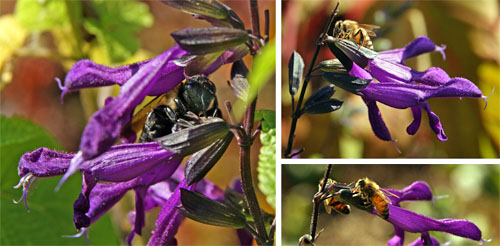
Grow blue anise sage in full sun. It will survive in partial shade but will be gangly and floppy with fewer flowers. It does best in fertile, well-drained soil. Plant 18-24” apart (closer in containers or when used as an annual). Unlike many sages, this species prefers regular water, especially in the heat of summer but do not allow it to remain wet. Pinch about monthly
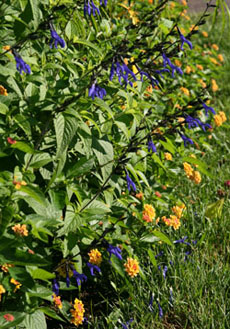
to keep plants full and compact. Fertilize container-grown plants monthly but when planted in the landscape they require little additional fertilizer or flower production will be reduced on taller, more brittle plants. Deadhead the flowers as they fade to encourage continued blooming. This species has few pests, especially when grown as an annual, but may suffer from powdery mildew or whiteflies.
The species can be grown from seed but cultivars are best propagated by cuttings (or division in spring in areas where the plants are hardy). Start seeds indoors 6-8 weeks before the average last frost and transplant outdoors when the soil has warmed and after all threat of frost is past. Softwood cuttings can be taken in spring or use semi-ripe cuttings in late summer or fall. Although cuttings are fairly easy to root even without rooting hormones, bottom heat enhances the results. Potted plants can be held over the winter in a bright, cool location. The tubers can also be harvested and stored in a very cool location (35-40˚F) similar to dahlia tubers. Dig in early autumn, leaving some soil around the rootball and store in a cool, dark location. The stem, stolons or rhizomes with nodes attached (as there are no eyes on the tubers that will sprout) need to be kept from drying out, but too much moisture will promote rot. When growth starts again in early spring move to a bright, warm spot.
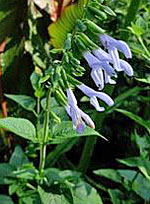
Blue anise sage is a good addition to annual or mixed beds. It also does well in containers. Several cultivars offer flowers in different shades:
- ‘Argentina Skies’ has pale blue flowers with a green calyx. The plants produce large tubers and many runners.
- ‘Black and Blue’ has striking cobalt blue petals and a nearly black calyx, along with very dark stems. It is more compact (2-3 ft) than the species or many other varieties, goes dormant in mild climates and readily produces tubers.
- ‘Blue Ensign’ has large medium blue flowers.
- ‘Costa Rica Blue’ blooms year-round in mild climates, with heaviest bloom from autumn into winter. It has dark violet-blue flowers and yellow-green calyces on tall plants.
-
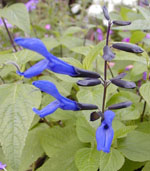
‘Black and Blue’
‘Omaha’ is a variegated form of ‘Costa Rica’ with yellow and green leaves. - ‘Purple Majesty’ is a hybrid of S. guaranitica and S. gesneraeflora from Huntington Botanical Gardens. It grows to 4 tall with bright green leaves and large purple flowers.
- ‘Purple Splendor’ has very dark, rich purple flowers.
– Susan Mahr, University of Wisconsin – Madison





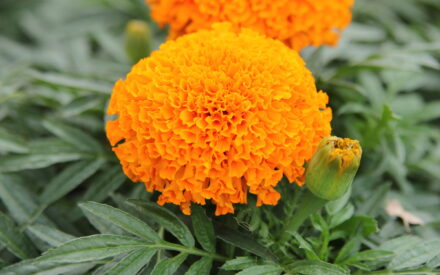 Marigolds
Marigolds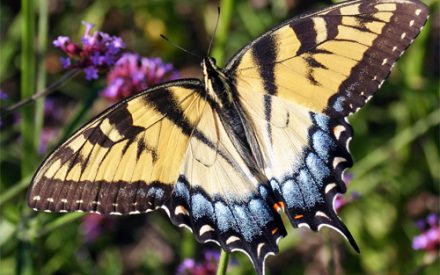 Create a Butterfly Garden
Create a Butterfly Garden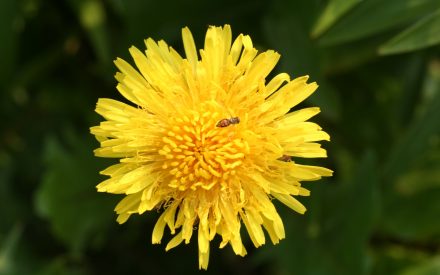 Plant Flowers to Encourage Beneficial Insects
Plant Flowers to Encourage Beneficial Insects Forcing Bulbs
Forcing Bulbs


